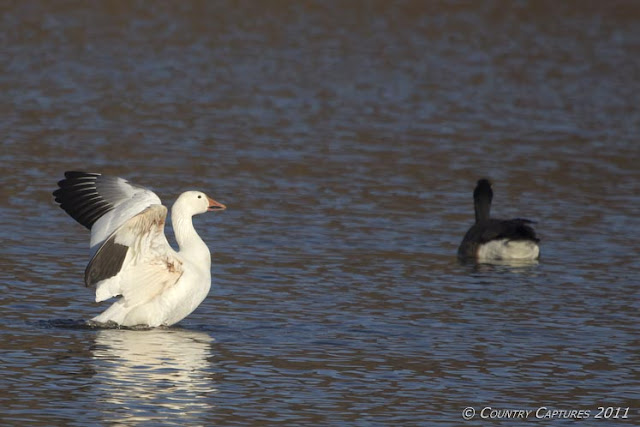This lone goose flying low is one of my favorite images from the day at Middle Creek.
I didn't realize until I was reviewing the day's shoot that I had photographed a goose wearing a neck collar
Cropping in tight allows one to read the identifying number. These collars are used by researchers as a means to identify individual birds from a distance.
Wildlife managers are concerned that an overabundance of snow geese will harm their Arctic breeding grounds and possibly the aquatic vegetation of their wintering areas, the Chesapeake Bay and Atlantic coastal marshes. In light of this concern spring hunting seasons with liberal bag limits allow hunting along their spring migration route. During our Middle Creek visit shotguns could be heard firing frequently nearby.
This goose, photographed at a pothole near the visitor center shows signs of injury, note the blood stains on its uplifted wing. A trend I noticed was that a goose sighted alone typically showed signs of injury.
We located this goose standing along the roadside appearing disoriented. When I stepped from the car it immediately took flight. Bloodied from a shotgun blast the bird was taking no further chances with humans. With thousands of miles yet to fly birds like these last two have little chance of survival. They will most likely either die of their injuries or fall prey to predators.






6 comments:
Coy, wonderful shots. I really like the fist two. I'm saddened by a spring hunting season. And an Autumn one as well! In my younger days I was a hunter, but only hunt with the camera now.
They have the same studies on the west coast, because of the huge numbers of snows. They haven't however decided on which course of action to take.
I hope they come up with something better than hunting. I hate the collateral damage too!
I love seeing birds when they are incoming for landing. Great shots.
The identification tube seems pretty tight to me. Seeing those injured birds tears at the heart strings.
Wonderful photos as always, but I agree, I can't stand to see them injured. If there were just another way . . .
Robin,
It seems that snow geese are considered a problem all across the country. I spent some time reading congressional testimony relating to the issue and some of the proposals, particularly by Canada, are downright scary ie napalm, poison etc. With that in mind hunting seems to be lesser of the evils imagined by wildlife managers. Maybe we are trying too hard to manage wildlife and mold it into our own ideals of how things should be.
Kjell, agree. That neck band does appear extremely tight. Probably put on when the goose was a juvenile.
Mona, wounding is a fact of life in hunting. A seldom mentioned fact but it does happen. I recently read one study that claims waterfowl hunters fatally wound at least 1 bird for every three bagged.
Great photos! The problem with under-managing or mis-managing snow geese is that their non-wintering habitats (wetlands all over North America) are at peril as well - and these are habitat shared by hundreds of threatened and endangered bird species.
When you see the damage that snow geese do to a salt marsh, it's easy to know why the migrating shorebirds are having trouble finding good feeding habitat on the return migration.
The Wildlife area up around here called Lake Ontelione is one of the many stops for the Snow Geese. Just about 2 weeks ago, while driving past the Lake, I noticed that the Snow Geese had arrived by the hundreds. Went back over there with my Camera the next day, but found they were gone! Guess that they don't hang around one area too long.
Les
Post a Comment